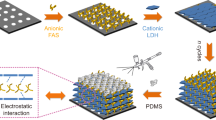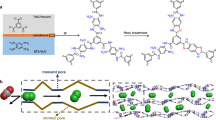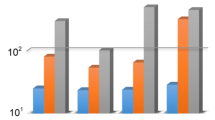Abstract
Amines are incorporated into various membranes to improve their CO2 separation performance. With amine-containing polymeric membranes, gas transport properties are often enhanced under humidity, where CO2 migrates through the membranes in the form of bicarbonate ions. Piperazine (Pz) and its derivatives are known to catalyze the conversion of CO2 to bicarbonate ions and have been used in liquid amine scrubbing technology. Piperazines were immobilized in poly(vinyl alcohol) (PVA), and the resulting polymeric membranes showed high CO2 separation performance over H2 and CH4. The gas transport properties were dependent on the chemical structure of the amines. In particular, 3-(1-piperazinyl)-1,2-propanediol (PzPD)-containing polymeric membranes gave excellent CO2 separation performance, and the CO2 permeability and CO2 selectivity over CH4 were 1060 Barrer and 370, respectively, at 50 °C and 90% relative humidity with a transmembrane CO2 pressure of 11 kPa. The interaction between PzPD and CO2 was quantitatively studied by inverse-gate decoupling 13C NMR spectroscopy. CO2 interacted with the secondary amino group on the Pz ring to form a carbamate, which was readily hydrolyzed to produce bicarbonate ions. The hydroxyl group on the C2 carbon of PzPD facilitated the interaction between CO2 and the amine through hydrogen bonding, resulting in enhanced diffusivity of CO2 in the membranes.
This is a preview of subscription content, access via your institution
Access options
Subscribe to this journal
Receive 12 print issues and online access
$259.00 per year
only $21.58 per issue
Buy this article
- Purchase on Springer Link
- Instant access to full article PDF
Prices may be subject to local taxes which are calculated during checkout








Similar content being viewed by others
References
Mets B, Davidson O, de Coninck H, Loos M, Meyer L. Carbon dioxide capture and storage. Cambridge: Cambridge University Press; 2005.
Styring P, Quadrelli EA, Armstrong K. Carbon dioxide utilization: closing the carbon cycle. New York: Elsevier; 2014.
Bui M, MacDowell N, Carbon Capture and storage. Cambridge: Royal Society of Chemistry; 2019.
20 Years of carbon capture and storage. International Energy Agency. 2016. https://webstore.iea.org/20-years-of-carbon-capture-and-storage. Accessed 5 Dec 2016.
Taniguchi I, Itaoka K. CO2 capture, transportation, and storage technology. In: Kato Y, Koyama M, Fukushima Y, Nakagaki T, editors. Energy technology roadmaps of Japan. Tokyo: Springer; 2016. p. 343–58.
Galizia M, Chi WS, Smith ZP, Merkel TC, Baker RW, Freeman BD. 50th Anniversary perspective: polymers and mixed matrix membranes for gas and vapor separation: a review and prospective opportunities. Macromolecules. 2017;50:7809–43.
Yang H, Xu Z, Fan M, Gupta R, Slimane RB, Bland AE, et al. Progress in carbon dioxide separation and capture: a review. J Environ Sci. 2008;20:14–27.
Basu S, Khan AL, Cano-Odena A, Liu C, Vankelecom IFJ. Membrane-based technologies for biogas separations. Chem Soc Rev. 2010;39:750–68.
Wang S, Li X, Wu H, Tian Z, Xin Q, He G, et al. Advances in high permeability polymer-based membrane materials for CO2 separations. Energy Environ Sci. 2016;9:1863–90.
Li P, Wang Z, Qiao Z, Liu Y, Cao X, Li W, et al. Recent developments in membranes for efficient hydrogen purification. J Membr Sci. 2015;495:130–68.
Seoane B, Coronas J, Gascon I, Benavides ME, Karvan O, Caro J, et al. Metal–organic framework based mixed matrix membranes: a solution for highly efficient CO2 capture? Chem Soc Rev. 2015;44:2421–54.
Kim SJ, Jeon H, Kim DJ, Kim JH. P25/PVC-g-POEM mixed matrix membranes with simultaneously improved permeability and selectivity for CO2/N2 separation. Polymer. 2016;40:238–44.
Merkel T. Pilot testing of a membrane system for post-combustion CO2 capture. US Department of Energy Office of Scientific and Technical Information. https://www.osti.gov/servlets/purl/1337555. Accessed 12 Dec 2019.
Han Y, Salim W, Chen KK, Wu D, Ho WSW. Field trial of spiral-wound facilitated transport membrane module for CO2 capture from flue gas. J Membr Sci. 2019;575:242–51.
Merkel T, Lin H, Wei X, Baker R. Power plant post-combustion carbon dioxide capture: an opportunity for membranes. J Membr Sci. 2010;359:126–39.
Chen Y, Ho WSW. High-molecular-weight polyvinylamine/piperazine glycinate membranes for CO2 capture from flue gas. J Membr Sci. 2016;514:376–84.
Vakharia V, Salim W, Wu D, Han Y, Chen Y, Zhao L, et al. Scale-up of amine-containing thin-film composite membranes for CO2 capture from flue gas. J Membr Sci. 2018;555:379–87.
Salim W, Han Y, Vakharia V, Wu D, Wheeler DJ, Ho WSW. Scale-up of amine-containing membranes for hydrogen purification for fuel cells. J Membr Sci. 2019;573:465–75.
Han Y, Wu D, Ho WSW. Simultaneous effects of temperature and vacuum and feed pressures on facilitated transport membrane for CO2/N2 separation. J Membr Sci. 2019;573:476–84.
Wang J, Wang S, Xin Q, Li Y. Perspectives on water-facilitated CO2 capture materials. J Mater Chem A. 2017;5:6794–816.
Taniguchi I, Duan S, Kai T, Kazama S, Jinnai H. Effect of the phase-separated structure on CO2 separation performance of the poly(amidoamine) dendrimer immobilized in a poly(ethylene glycol) network. J Mater Chem A. 2013;1:14514–23.
Taniguchi I, Urai H, Kai T, Duan S, Kazama S. A CO2-selective molecular gate of poly(amidoamine) dendrimer immobilized in a poly(ethyleneglycol) network. J Membr Sci. 2013;444:96–100.
Bishnoi S, Rochelle GT. Absorption of carbon dioxide into aqueous piperazine: reaction kinetics, mass transfer and solubility. Chem Eng Sci. 2000;55:5531–43.
Conway W, Fernandes D, Beyad Y, Burns R, Lawrance G, Puxty G, et al. Reactions of CO2 with aqueous piperazine solutions: formation and decomposition of mono- and dicarbamic acids/carbamates of piperazine at 25.0 °C. J Phys Chem A. 2013;117:806–13.
Ciftja AF, Hartono A, Svendsen HF. 13C NMR as a method species determination in CO2 absorbent systems. Int J Greenh Gas Control 2013;16:224–32.
Stowe HM, Paek E, Hwang GS. First-principles assessment of CO2 capture mechanisms in aqueous piperazine solution. Phys Chem Chem Phys. 2016;18:25296–307.
Sherman BJ, Ciftja AF, Rochelle GT. Thermodynamic and mass transfer modeling of carbon dioxide absorption into aqueous 2-piperidineethanol. Chem Eng Sci. 2016;153:295–307.
Ying J, Raets S, Eimer D. The activator mechanism of piperazine in aqueous methyldiethanolamine solutions. Energy Procedia. 2017;114:2078–87.
Wang T, Liu F, Ge K, Fang M. Reaction kinetics of carbon dioxide absorption in aqueous solutions of piperazine, N-(2-aminoethyl) ethanolamine and their blends. Chem Eng J. 2017;314:123–31.
Taniguchi I, Kai T, Duan S, Kazama S, Jinnai H. A compatible crosslinker for enhancement of CO2 capture of poly(amidoamine) dendrimer-containing polymeric membranes. J Membr Sci. 2015;475:175–83.
Gaume J, Wong-Wah-Chung P, Rivaton A, Therias S, Gardette JL. Photochemical behavior of PVA as an oxygen-barrier polymer for solar cell encapsulation. RSC Adv. 2011;1:1471–81.
Kim HM, Lee JK, Lee HS. Transparent and high gas barrier films based on poly(vinyl alcohol)/graphene oxide composites. Thin Solid Films. 2011;519:7766–71.
Masuda M. Recent advances in polyvinyl alcohol films. In: Finch CA, editor. Polyvinyl alcohol—developments. 2nd ed. New York: Wiley; 1992. p. 403–32.
National Astronomical Observatory of Japan. Chronological scientific tables 2020. Tokyo: Maruzen; 2019.
Jakobsen JP, da Silva EF, Krane H, Scendsen F. NMR study and quantum mechanical calculations on the 2-[(2-aminoethyl)amino]-ethanol–H2O–CO2 system. J Magn Reson. 2008;191:304–14.
Yamada H, Matsuzaki Y, Chowdhury F, Higashii T. Computational investigation of carbon dioxide absorption in alkanolamine solutions. J Mol Model. 2013;19:4147–53.
Taniguchi I, Kinugasa K, Toyoda M, Minezaki K. Effect of amine structure on CO2 capture by polymeric membranes. Sci Technol Adv Mater. 2017;18:950–8.
Acknowledgements
This research is supported by JST ALCA Grant Number JPMJAL1403 and JSPS KAKENHI Grant Number JP17K05966, Japan. The WPI-I2CNER is supported by the World Premier International Research Center Initiative (WPI), MEXT, Japan. The authors would like to thank Mr. Tomonori Oda for helping with the membrane preparations and gas separation experiments. HT and KM acknowledge the support of the Kyushu University Future Creators in Science Project (QFC-SP) by the JST Global Science Campus Project, Japan.
Author information
Authors and Affiliations
Corresponding author
Ethics declarations
Conflict of interest
The authors declare that they have no conflict of interest.
Additional information
Publisher’s note Springer Nature remains neutral with regard to jurisdictional claims in published maps and institutional affiliations.
Rights and permissions
About this article
Cite this article
Taniguchi, I., Kinugasa, K., Toyoda, M. et al. Piperazine-immobilized polymeric membranes for CO2 capture: mechanism of preferential CO2 permeation. Polym J 53, 129–136 (2021). https://doi.org/10.1038/s41428-020-0389-7
Received:
Revised:
Accepted:
Published:
Issue Date:
DOI: https://doi.org/10.1038/s41428-020-0389-7
This article is cited by
-
Hydrogel particles for CO2 capture
Polymer Journal (2024)
-
Special issue: CO2: capture of, utilization of, and degradation into
Polymer Journal (2021)



